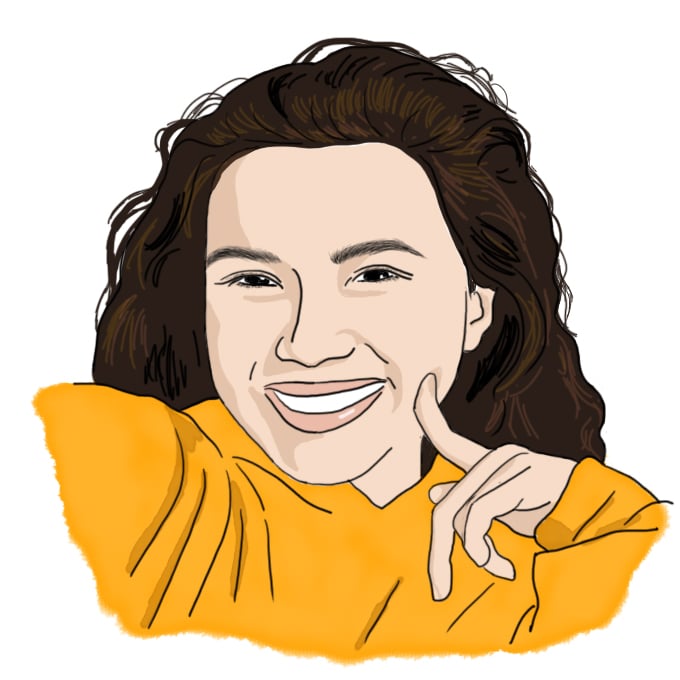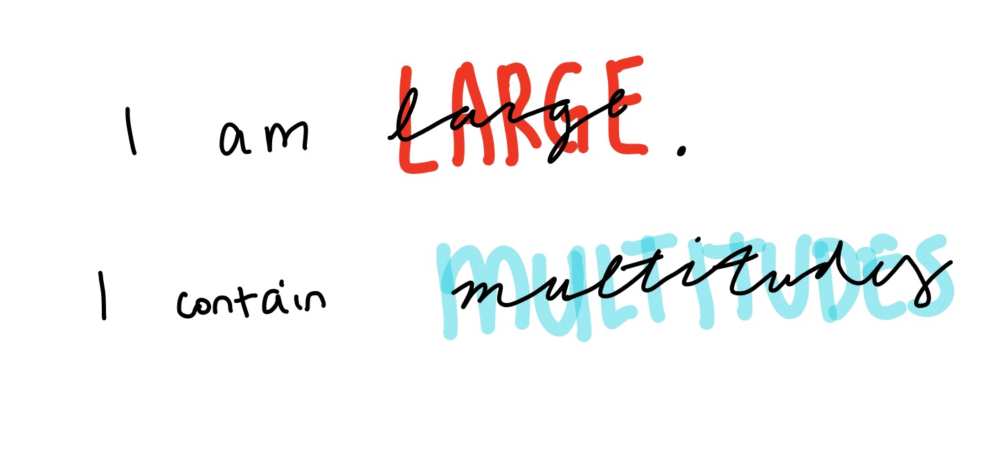
oh, the places you’ll go by Cami M. '23
In my freshman year of high school, my favorite teacher that year had a quote that sat right above his whiteboard, visible at every place in the classroom. It read “I am large. I contain multitudes.”
Every lesson would somehow tie back to this quote, as we learned more and more about humans and their time on this earth (it was AP Human Geography after all) and how things we considered to be brief or tiny, such as paragraphs in a textbook we’re all forced to read for class, were in fact monumentous and grand and large. All it took for us to understand that was a little more thought, a little more practice, and a little more understanding.
In that class, every time I looked up at that quote, I felt my chest puff out a bit more, felt myself straighten up a little taller, and, as my eyes glanced across each word, I felt a little bigger. Larger.
I didn’t quite realize that these laminated words atop a dirty whiteboard would stick with me as much as they did, but even now, I think back to it.

In the eighth grade, while we were all fracturing off to different high schools to pursue different journeys, our eighth grade teachers gifted each of us a custom version of Dr. Seuss’s Oh, The Places You’ll Go! Every page contained one of our names on it, saying we were all traveling off to different far away lands to do great things.
In the moment, I didn’t really think much of it. I really wasn’t dreaming of all the places I was going to go, I was more focused on the prospect of high school.
Throughout high school, I was deadset on finality and sureness. I hated spontaneity and the mere thought of breaking away from my set out plan and goals was ludicrous. As I tediously planned out my next four years of school and made a notes document of everything I wanted to accomplish in high school, I was determined to complete everything I set out to do.
In my freshman year, I dabbled around with major ideas. I knew I wanted it to be something in STEM, solely because I liked it well enough and I was decent at it. I entertained the idea of psychology, until my biology teacher scoffed and said that psychology was a fake science and didn’t deserve any respect. In my sophomore year, I took Biomedical Engineering and realized I liked making things and working in lab and I decided I’d be a BME major, and that was that. This was the same year I visited my friend Claire H. ’20 at MIT, fell in love with the school, and promptly decided to hate MIT for the rest of my high school career because I so desperately wanted to attend and the 6.7% acceptance rate was most definitely not my friend.
For the next two years, I continued to be a BME major and swore I would not apply to MIT because I wanted to ED Johns Hopkins’ BME program.
But in a very unlike-Cami fashion, I made the spontaneous decision to apply EA to MIT on a whim. Which brings us here. To now. Me, a computer science major at MIT.
I think a lot about 8th grade Cami, sitting in the auditorium with her book and not even being able to fathom the fact that 6 years later she’d be sat in a cafe in Boston, hunched over her laptop coding for her lab for her computer science class at MIT.
My life could’ve gone in many directions. Instead of being perched here in Massachusetts, I could be a BME major at Johns Hopkins, sat in the nook of some cafe in Baltimore. Or perhaps I could be in a fancy diner in the neighborhoods of LA, just a stone’s throw from USC. I think about these alternate realities often, wondering if I hadn’t gotten into MIT, if I would be in a similar position.
Because I wasn’t meant to be a computer science major, or at least I thought I wasn’t. Constructors didn’t make sense to me, variables were a jumbly mess, for loops and recursion made my head spin. I swore after APCSA I’d never touch it again, but for some reason, something about MIT made me want to pick it up again.
And as I code away, using recursion to build nth dimension Minesweeper for 6.009, I think not only about 8th grade Cami, but 9th grade Cami, too, who was only just beginning to comprehend her many dimensions and multitudes.
I often wonder what it would be like to meet my eighth grade or ninth grade self, eagerly showing them my cute planner decorated with MIT-themed stickers (I hated stickers as a kid) or my IDE and its cute color theme (I didn’t know what an IDE was until this past January). I like to think it would’ve inspired me to keep on chugging or would’ve made me less anxious and so determined to be right and sure all the time, since future me was so vastly different from what I had imagined. Rather than some BME major at Hopkins proudly donning the light blue as my feet pitter pattered against the brick walkways of Baltimore, I was a Cambridge body with an MIT lanyard that held the keys to my first ever apartment and an MIT-issued iPad that stored all my notes and scribbles for my difficult coding classes.
In reality, I think I’d probably break the laws of time travel and probably have something go horribly, horribly wrong if I ever did meet my past selves. Unfortunate.
So, I know, Cami, where are you going with this? Well, I’m proud of myself. Really, that’s all. I am so incredibly proud of how far I’ve gotten and all the places I’ve gone. I’m proud of how large I’ve become and the multitudes I’ve discovered. I’m proud of the Cami I have become. I look at where I was and where I am now and I’m so overwhelmed with how much I’ve progressed, how much I contained within me, and how much I have done.
“I am large. I contain multitudes.”
I would later learn that this quote was just the second half of an even more meaningful one: “Do I contradict myself? Very well, then I contradict myself. I am large, I contain multitudes.” For me, at least, I see this as proof that humanity is inherently flawed, yet fixable. Unreliable, yes, but we still learn. We may have some idea of how some things work, but once we learn, we grow, and we contradict our previous self. This is a similar concept to a recent video from John Green, where he talks of a poem that opens with “Twenty men crossing a bridge, Into a village, Are Twenty men crossing twenty bridges.”
For a while, I questioned why certain classes took longer for me to understand and comprehend than my peers. Why certain things about computer science excited others but did not excite me. Why I seemed to be struggling more at MIT than the peers who have traversed this same road.
The reality of situation, though, is that the road is not at all the same. I have my own MIT, just as my peers have their MIT and those men have their own bridges. And as I journey through my own MIT, I’m constantly contradicting myself, growing larger and larger.
John Green ended his explanation by simply saying that the response to “What’s the bridge like?” is not “This bridge is terrifying,” but rather, “My bridge is terrifying, how ’bout yours?” and it really is reminiscent of something I was once told as a prefrosh at CPW by some upperclassmen at MIT.
Being nervous little prefrosh, we asked the wise upperclassman just exactly how difficult is MIT. He thought for a second, pausing, before giving his long response. I wish I could write it down verbatim, but I’ll just include the most important part: “MIT is an infinite ice cream shop, and everyone is going through their own special little flavor of hell. And the best part is, everyone knows that and gets that. So we help each other out.”